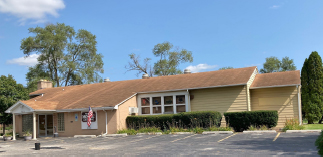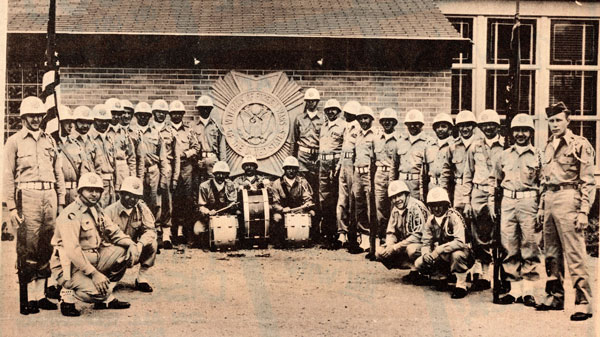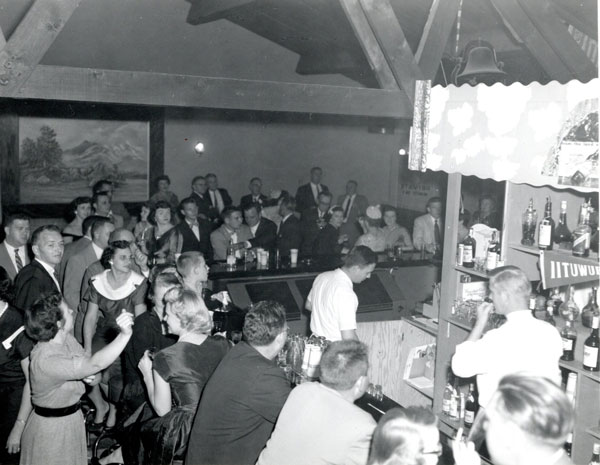
By Jean Murphy
The unassuming brick and mustard-colored structure on the east side of Route 83 at East Highland Street has housed the local Moose Lodge since 1983, but it played an even more vital role in the Mount Prospect of the 1950s, 60s and 70s when it was the headquarters of VFW Post 1337.
Local World War II veterans (with the help of a few World War I vets) constructed the clubhouse themselves between 1949 and 1950. The local Post had been chartered in 1925 and originally met in a farmhouse at 51 N. Wille Street, which has since been torn down. In the 1920s this meeting place was on the outskirts of town; there is even an advertisement in The Herald for a trap shooting event at the Post in 1927. Then, in 1933 they moved to the old John Katz farmhouse at the corner of Elmhurst Avenue and Memory Lane, which burned in 1975.
Over the years Post 1337 contributed to the community, donating elm trees to be planted along Main Street and flagpoles and even a trench mortar from World War I to be placed in front of Village Hall.
But when there was a fresh influx of former GIs from the Second World War, Post 1337 realized that they needed a larger clubhouse. Fortunately, property at 601 N. Main Street was donated, purportedly by a member of the Busse family (but since we can’t currently access Torrens records in the County Building, we can’t be sure which one). The property included the large parcel we see today, as well as the land which now holds the water tanks of the Illinois American Water Company. The VFW donated a portion of their land for that public interest purpose in 1964.
Veterans from both wars worked on the new structure for a full year. “Everyone pitched in their skills,” according to Bob McKillop who served in the Air Force during both Korea and Vietnam.
“Members wanted the interior to tie in with the Tudor-style décor in downtown Mount Prospect, so they designed the bar with a Tudor look. The beautiful, elaborate bar features curved wood and railings, built by VFW members. The members also used pulleys and hoists to place the distinctive roof beams – done like an Amish barn-raising! Outdoors the building was designed so the front would blend in with the houses farther south on Main Street, because the veterans did not want the VFW to look like a commercial building,” McKillop continued.
“The WWI and WWII guys worked together on the project. They were committed to building their own home in town, so they didn’t refuse to do anything, And, there IN THIS ISSUE: were so many of them. Twenty percent of the population had served,” he added.
It is important to remember that when they were constructing the clubhouse, this was very much the edge of town. Randhurst had not yet been built. The VFW clubhouse was one of Mount Prospect’s only community gathering places!

On the nights of VFW meetings (which often attracted 40-50 members at a time), only VFW members were welcome at the Hall, but other nights it was open to the public. The back room had a small stage which was used for amateur shows and bands hired for dances. The Hall was rented for weddings (including the 1955 wedding of Wayne Busse and Grace Rapp), banquets, birthday parties, high school parties and much more. The veterans used the space for Memorial Day and Veterans Day gatherings, bingo games, fund-raising dinners and much more.
The kitchen is in the basement and next to it there was a small room with a fireplace which was used for small VFW meetings. Often, they didn’t want to spend the money to stoke up the boiler for heat, McKillop recalled.
The VFW Women’s Auxiliary played a pivotal role in running and maintaining the VFW Hall. They were the “unsung heroes” who held fish frys, picnics, dinners, bake sales and more and largely carried the VFW Hall’s maintenance costs for many years.
And whenever the Hall needed maintenance, members stepped up. McKillop remembers 30 guys showing up to scrape and paint the Hall’s exterior when necessary.
Mount Prospect Trustee Mike Zadel managed the Hall from 1972 to 1974. He was only in his 20s at the time and had never served in the Armed Forces, but he worked 12 hours a day, seven days a week.

In those days the World War I and II veterans were passing away or becoming less active, so the VFW couldn’t get enough volunteers to run the place and had to hire outside management. The veterans continued to host fundraisers like the Friday fish frys and Tuesday bingo, but leased the building to others for the day-to-day operations. The lessees served refreshments and bar food. The lessees supplemented their income by renting the back room for parties (including the 25th anniversary party of Mayor Bob Teichert and his wife, Alice, in the mid-1970s), small weddings, quinceañeras, funeral lunches etc.
At that time there were no women members, but men from outside the VFW ranks were permitted to join as social members for $15 per year.
The bar attracted between seven and 20 people most nights, but Friday nights were busy, attracting 40 to 45 people. “The social members kept it going in those days,” Zadel said.
In early 1983 the VFW sold the building to Moose Lodge 660, but they returned twice a month for meetings until they found a different meeting place.
The VFW has recently chosen to hold their meetings back at their former home at the current Moose Lodge.
To view this year’s Veteran’s Day ceremony live, tune in at 10 a.m., November 11 to the Village web-site or Channel 17 on Comcast or WOW or for delayed viewing visit the Village of Mount Prospect’s YouTube channel.